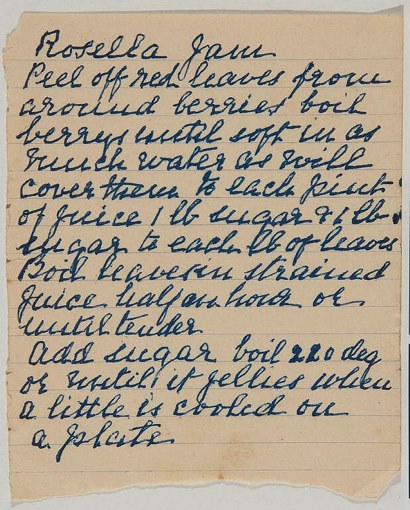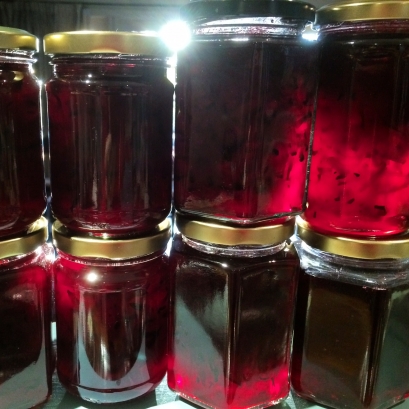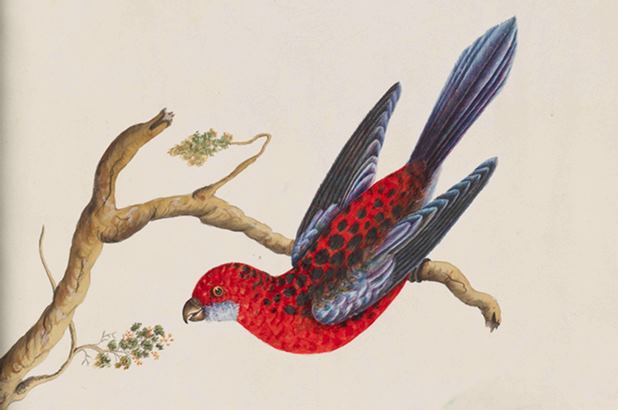Taking advantage of the relative calm that the new year has brought, I’ve been savouring some of the manuscript and heirloom recipes in our collections. Expect to find in the next few weeks a thatched roof pie, a meat souffle and sago plum pudding, but today’s pick is ‘Rosella Jam’.
A family legacy
This diminutive piece of paper written in what seems to be a somewhat shaky and perhaps elderly hand, was found among June Wallace’s papers – June was the last in the family line to occupy Meroogal (you can spend some time with June in the family home here). Many of us will recognise the rosellas as wild hibiscus ‘flowers’ from Hibiscus sabdariffa which are preserved in syrup and added to a glass of sparkling wine or mineral water, but they were popular in the 19th and early 20th centuries to make a sweet preserve to use as a spread or as an alternative to cranberry sauce or redcurrant jelly for turkey or lamb.

Rosella jam recipe. June Wallace papers, Caroline Simpson Library and Research Collection. © Sydney Living Museums
Pretty, tasty
The rosella plant is an attractive addition to the garden, and possibly why it was much admired by colonists, with its wine coloured branches, dark green leaves, pale yellow flowers contrasted with dark maroon centres and exotic looking calyces. In fact it isn’t the flower (which can be white or yellow) that is used but the deep red finger-like fronds, called ‘sepals’ which in turn, form part of the ‘calyx’ that includes the seed pod. The sepals can be eaten raw, and are pleasantly tart; once cooked they are fragrant and reminiscent of rhubarb. The leaves of the rosella plant are also edible, having a delicious sorrel-like lemony tang to them, and are a lovely addition to Thai-style salads.

Rosella ‘fruit’ or calyces growing in the kitchen garden at Vaucluse House. Photo © James Horan for Sydney Living Museums
Friend or foe?
Purists will tell you the rosella is not native but endemic to Australia – hence its ‘wild’ status rather than native. According to heritage horticulturalist Dave Grey it has been in Australia for 15,000 years so we can be forgiven for thinking it a native plant but in northern Australia it is deemed a weed. It is understood that it originated in India or Malaysia, spread across tropical regions of Africa, Hawaii and other equatorial island groups and eventually, to Australia. Known in English as rozelle, roselle or rosella, it has also been known as red sorrel, Indian sorrel, Queensland jelly plant, lemon bush and Florida cranberry [1].

Rosella ‘sepals’ in the pot. Photo Jacqui Newling © Sydney Living Museums
Cherished memories
Following a recent article in the Sydney Morning Herald about our new book Eat your history: stories and recipes from Australian kitchens I received a very lovely note from a reader, Marion Anderson, whose memories flooded back when reminded of the rosella plant:
‘It took me back to my childhood at Tingalpa, Brisbane, 1932 – 1953. My father used to grow rosellas each year and my mother made pots and pots of jam with them – delicious!’ .

Freshly bottled rosella jam. Photo Jacqui Newling for Sydney Living Museums
A cook’s confession
I’ve been the lucky recipient of whole rosella ‘fruit’ from our kitchen gardens but making jam from them requires quite a bit of work, separating the red fronds from the seed pod, or berry, as it is referred to in this recipe. The seed pod provides the necessary pectin to make the jam set, but green apples or commercial pectin can do the same job. Having been averse to the painstaking task of separating the sepals from the pod, I have always used rosellas to make a jelly, cooking up the whole fruit and straining off the resulting syrup. As this time I was making jam for a public consumption I bought food grade rosella sepals from a commercial supplier and rather than using green apples instead of seed pods, cheated again and used commercial pectin. The advantage of this was that I ended up with an undiluted product, rich in colour with a full fruit flavour.
![Crimson Rosella. Pennantian P[arrot] (Detail). Watercolour on paper watermarked ‘J Whatman’. Volume 04: Zoology of N. [New] Holland etc. [Album view] item 43. © State Library of New South Wales PXD 1098 / vol. 4](../../app/uploads/sites/2/2015/10/xCrimson-Rosella.-J-Whatman-Mitchell-Library-SLNSW-item-45.jpg.pagespeed.ic.Hv2smwhLfF.jpg)
Crimson Rosella. Pennantian P[arrot]. Watercolour on paper watermarked ‘J Whatman’. Volume 04: Zoology of N. [New] Holland etc. [Album view] item 43. © State Library of New South Wales PXD 1098 / vol. 4

![By Bernard DUPONT from FRANCE (Crimson Rosella (Platycercus elegans)) [CC BY-SA 2.0 (http://creativecommons.org/licenses/by-sa/2.0)], via Wikimedia Commons](../../app/uploads/sites/2/2015/10/xCrimson_Rosella_Platycercus_elegans_-wiki-commons.jpg.pagespeed.ic.rrJkzQCVWY.jpg)


